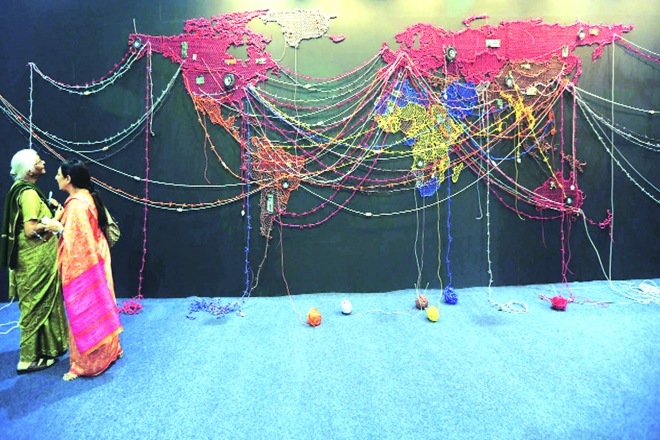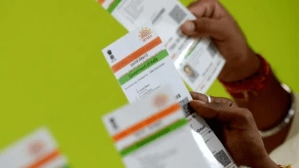The India Art Fair, now into its ninth edition, has always been supporting the unique forms of art that the region has to offer. Continuing with the trend, the organisers have put major focus on an extensive ‘art projects’ programme spanning the outdoor and indoor fair spaces this year.
On view are some never-seen-before offerings such as Pakistani-American artist Anila Quayyum Agha’s internationally-acclaimed All the Flowers are for Me. Playing with light and space and suspended from the ceiling of an otherwise empty space, the steel, box-like structure features ornate and elaborately detailed laser cut-outs of floral patterns and geometric motifs. When lit from the inside, the cube casts lace-like shadows on to the walls, floor, and even the ceiling, bathing the entire space in ‘dancing light’. The installation has apparently been put up for public viewing for the first time in India. Bangladesh-based Britto Arts Trust’s No Man’s Land is another art project that has the viewers raving about. It shares the works and memories of an Indo-Bangladeshi collaborative effort of 2014, where artists from the two sides met at the border, without any visa, watched over by the border guards. Then, there is the captivating project by Mumbai-based visual artist Reena Saini Kallat called Woven Chronicle. Visitors going towards the VIP Lounge area will not miss the huge ‘map’ on the makeshift wall, woven by electric wires as if they were yarn. As per Kallat, the map “traces the routes of contract workers, indentured labourers, asylum-seekers, refugees, and other migrants across the planet”. The wires act as both conduits and barriers, simultaneously referring to global networks of communication and commerce, as well as to barbed wires or fences.
Also, not to be missed are the rare photographs of Mahatma Gandhi that were taken by Kanu Gandhi. Kanu (1917-1986) was the son of Narandas Gandhi, a nephew of Mahatma Gandhi. Two years after his birth, the family moved to Sabarmati Ashram, where Narandas worked as a manager. In 1934, Gandhi came to Wardha in central India and founded Sevagram, which soon became a bustling ashram. Though Kanu wanted to be a doctor, in 1936, he was persuaded by his father to join Gandhi’s personal staff at Sevagram, where he came to be known as ‘Bapu’s Hanuman’. It was during this time that Kanu developed an interest in photography and persuaded Gandhi to allow him to photograph him. As per reports, “Gandhi imposed three conditions on Kanu: that he would never use a flash; that he would never ask him to pose; and that the ashram would not fund his photography”. So what you get to see are a host of candid moments that were hidden to the public all this while.
You may also like to watch this video
A much talked about section this year has also been Vernacular In Flux, a new section curated by Bengaluru-based designer and art historian Annapurna Garimella. It showcases Gond and Madhubani art, as well as Mysore and Guruvayur paintings and sculptures, featuring artists such as Bhajju Shyam, Vimla Dutta, Mahalaxmi, Baua Devi and Santanu K. “It highlights practitioners of vernacular (tribal and folk) art forms, the largest group of artists in India today. If we are representative of arts from the region, we can’t ignore the link of folk and tribal with contemporary art,” says Neha Kirpal, founding-director of the India Art Fair. Art house DAG Modern is displaying, among others, FN Souza’s Man and Woman Laughing, a 1957 oil on masonite that famously fetched Rs 16.84 crore at a Saffronart auction in 2015. A rare treat for art connoisseurs.









